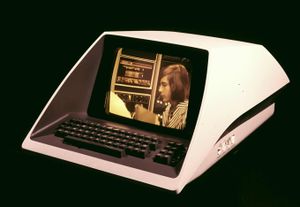Difference between revisions of "VT05 Alphanumeric Display Terminal"
m (avoid redirs) |
m (New cat) |
||
| (One intermediate revision by the same user not shown) | |||
| Line 10: | Line 10: | ||
It could also accept video input, and display that alongside text; video output was also produced. | It could also accept video input, and display that alongside text; video output was also produced. | ||
| + | |||
| + | ==External links== | ||
| + | |||
| + | * [https://vt100.net/docs/vt05-rm/ VT05 alphanumeric display terminal reference manual] (DEC-00-H4AC-D) | ||
| + | * [http://highgate.comm.sfu.ca/pdp8/newstuff/dec-00-h4bd-d.tif VT05 alphanumeric display terminal maintenance manual] (DEC-00-H4BD-D) | ||
| + | * [http://www.bitsavers.org/pdf/dec/terminal/vt05/DEC-VT05-IPB-1.pdf VT05 alphanumeric display terminal Illustrated Parts Breakdown] (DEC-VT05-IPB-1) | ||
| + | * [http://www.bitsavers.org/pdf/dec/terminal/vt05/VT05_Engineering_Drawings_Jun71.pdf VT05 alphanumeric display terminal engineering drawings] | ||
{{Nav DEC Terminals}} | {{Nav DEC Terminals}} | ||
| − | [[Category: DEC | + | [[Category: DEC Video Terminals]] |
| − | |||
Latest revision as of 23:13, 26 May 2023
The VT05 Alphanumeric Display Terminal (technically, the VT05B, but documentation usually referred to it as the 'VT05') was one of DEC's first video terminals. It supported all the same format control characters as a Teletype, so it was a 'drop in' replacement.
Physically, it was 12"Hx19"Wx30"D, and weighed 55lbs. Its circuitry was contained on seven modules to aid maintenance.
The display was 10-1/8"x7-5/8", and could hold 72Wx20H characters, using a 5x7 font, producing characters .22"x.10", upper-case only. (It could send lower- and upper-case from the keyboard, however.) It also supported addressable screen output, using a cursor which could be placed anywhere on the screen, with output being placed at the cursor location.
Its asynchronous serial line interface supported both RS-232 and 20mA at baud rates of 110 to 2400 baud, including several split speed combinations (e.g. 110 out and 2400 in). It could operated in both half-duplex and full-duplex modes.
It could also accept video input, and display that alongside text; video output was also produced.
External links
- VT05 alphanumeric display terminal reference manual (DEC-00-H4AC-D)
- VT05 alphanumeric display terminal maintenance manual (DEC-00-H4BD-D)
- VT05 alphanumeric display terminal Illustrated Parts Breakdown (DEC-VT05-IPB-1)
- VT05 alphanumeric display terminal engineering drawings
| v • d • e DEC Terminals and Printers |
|---|
| Hardcopy Terminals - DECwriter • DECwriter II • DECwriter III • DECwriter IV
CRT Terminals - VT05 • VT52 • VT100 • VT220 • VT240 • VT320 Monitors - VR201 |
